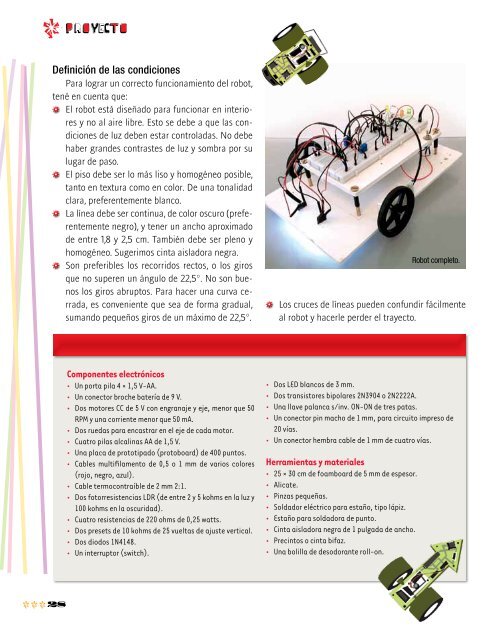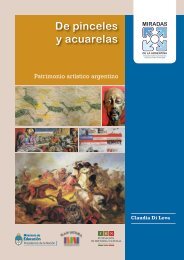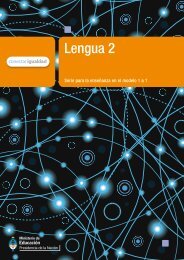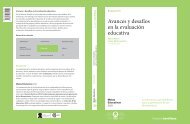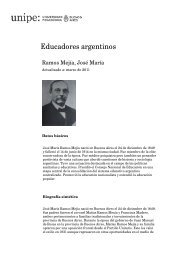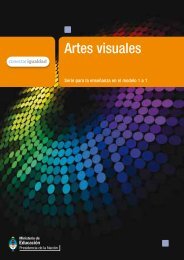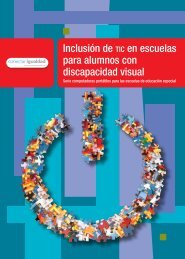Robótica - Biblioteca de Libros Digitales - Educ.ar
Robótica - Biblioteca de Libros Digitales - Educ.ar
Robótica - Biblioteca de Libros Digitales - Educ.ar
Create successful ePaper yourself
Turn your PDF publications into a flip-book with our unique Google optimized e-Paper software.
p r o YeCt oDefinición <strong>de</strong> las condicionesP<strong>ar</strong>a logr<strong>ar</strong> un correcto funcionamiento <strong>de</strong>l robot,tené en cuenta que:El robot está diseñado p<strong>ar</strong>a funcion<strong>ar</strong> en interioresy no al aire libre. Esto se <strong>de</strong>be a que las condiciones<strong>de</strong> luz <strong>de</strong>ben est<strong>ar</strong> controladas. No <strong>de</strong>behaber gran<strong>de</strong>s contrastes <strong>de</strong> luz y sombra por sulug<strong>ar</strong> <strong>de</strong> paso.El piso <strong>de</strong>be ser lo más liso y homogéneo posible,tanto en textura como en color. De una tonalidadcl<strong>ar</strong>a, preferentemente blanco.La línea <strong>de</strong>be ser continua, <strong>de</strong> color oscuro (preferentementenegro), y tener un ancho aproximado<strong>de</strong> entre 1,8 y 2,5 cm. También <strong>de</strong>be ser pleno yhomogéneo. Sugerimos cinta aisladora negra.Son preferibles los recorridos rectos, o los girosque no superen un ángulo <strong>de</strong> 22,5°. No son buenoslos giros abruptos. P<strong>ar</strong>a hacer una curva cerrada,es conveniente que sea <strong>de</strong> forma gradual,sumando pequeños giros <strong>de</strong> un máximo <strong>de</strong> 22,5°.Robot completo.Los cruces <strong>de</strong> líneas pue<strong>de</strong>n confundir fácilmenteal robot y hacerle per<strong>de</strong>r el trayecto.Componentes electrónicos• Un porta pila 4 × 1,5 V-AA.• Un conector broche batería <strong>de</strong> 9 V.• Dos motores CC <strong>de</strong> 5 V con engranaje y eje, menor que 50RPM y una corriente menor que 50 mA.• Dos ruedas p<strong>ar</strong>a encastr<strong>ar</strong> en el eje <strong>de</strong> cada motor.• Cuatro pilas alcalinas AA <strong>de</strong> 1,5 V.• Una placa <strong>de</strong> prototipado (protobo<strong>ar</strong>d) <strong>de</strong> 400 puntos.• Cables multifilamento <strong>de</strong> 0,5 o 1 mm <strong>de</strong> v<strong>ar</strong>ios colores(rojo, negro, azul).• Cable termocontraíble <strong>de</strong> 2 mm 2:1.• Dos fotorresistencias LDR (<strong>de</strong> entre 2 y 5 kohms en la luz y100 kohms en la oscuridad).• Cuatro resistencias <strong>de</strong> 220 ohms <strong>de</strong> 0,25 watts.• Dos presets <strong>de</strong> 10 kohms <strong>de</strong> 25 vueltas <strong>de</strong> ajuste vertical.• Dos diodos 1N4148.• Un interruptor (switch).• Dos LED blancos <strong>de</strong> 3 mm.• Dos transistores bipol<strong>ar</strong>es 2N3904 o 2N2222A.• Una llave palanca s/inv. ON-ON <strong>de</strong> tres patas.• Un conector pin macho <strong>de</strong> 1 mm, p<strong>ar</strong>a circuito impreso <strong>de</strong>20 vías.• Un conector hembra cable <strong>de</strong> 1 mm <strong>de</strong> cuatro vías.Herramientas y materiales• 25 × 30 cm <strong>de</strong> foambo<strong>ar</strong>d <strong>de</strong> 5 mm <strong>de</strong> espesor.• Alicate.• Pinzas pequeñas.• Soldador eléctrico p<strong>ar</strong>a estaño, tipo lápiz.• Estaño p<strong>ar</strong>a soldadora <strong>de</strong> punto.• Cinta aisladora negra <strong>de</strong> 1 pulgada <strong>de</strong> ancho.• Precintos o cinta bifaz.• Una bolilla <strong>de</strong> <strong>de</strong>sodorante roll-on.28


